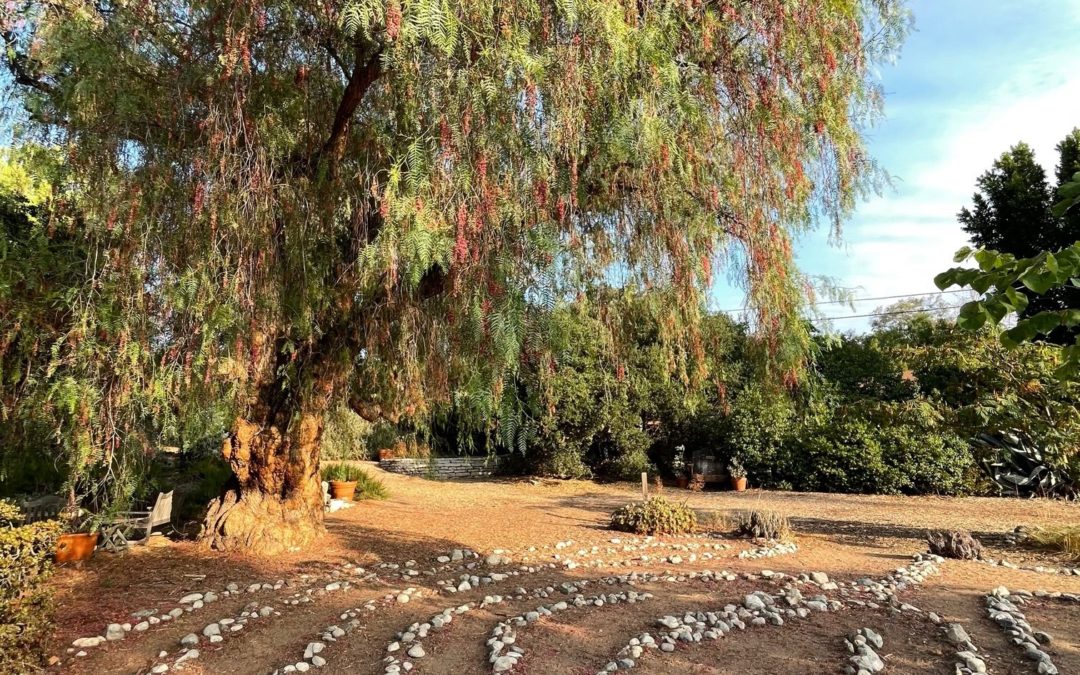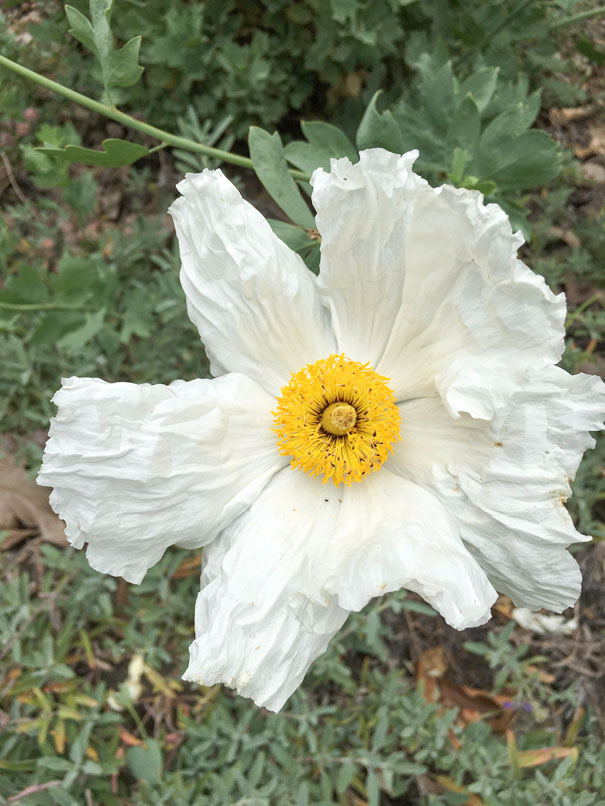Life on Earth is faced with incredible ecological challenges. In response, we can devote a portion of our personal landscapes to the natural world — a horticultural sacred share: a portion set aside in our yards or balconies for life on Earth.* In our newly-revived native plant gardening advice column, we ask different gardeners (including Arlington’s experts) for their seasonal advice on habitat gardening in our shared landscapes.
(AJ) Winter is coming, which (contra HBO) is Southern California’s magical season of abundance. What should gardeners expect to see, for instance, between now and the new year?
(TS) Native plants will be soaking up winter rains for robust, healthy, deeply rooted growth in preparation for the dry summer months. Wildflower seeds will germinate and begin to show a light green fuzz. Winter food for birds and bees like toyon and manzanitas will be blooming. And we can enjoy the initial lull of winter before the burst of spring booms and the wildflower show begins.
(AJ) Can gardeners also take a rest right now? Or should we be hard at work?
(TS) Assuming that you aren’t planting a new garden or hand-watering, the gardener can also take a break from sheet mulching, planting, seeding, and so on. Simply sit back and wait for it to warm up again!
(AJ) I have a lawn *well, my landlord has a lawn* that I have planned to get rid of — can I start that process now? What method(s) have you used to kill lawns?
(TS) Nine out of ten times, when I’ve sheet-mulched lawns, I have [managed to] remove them. I take the long road beginning by turning the water off in late spring and sheet-mulching directly over the grass. I irrigate a few times a month after mulching, so that whatever needs to grow will poke its head out, and I can pull it by hand. I turn the water off completely by July, however, and just let the grass roast for the rest of the summer. It’s toast by October – the soil enriched and ready for planting natives.
(AJ) So sheet mulching should wait for the summer months … is there anything that a gardener can do now, if they want to get started with removing a lawn?
(TS) Yes, in winter, sheet mulching is not as effective. It’s going to keep raining and the grass underneath will keep growing and poking through. So why not try this instead: Firstly, I would work on your garden design. You should figure out what species you want to plant and where they will be located in your yard. Once you have figured this out – rather than removing your entire lawn – start by cutting out a bunch of holes in the sod, around 2 feet by 2 feet, and transpose your design onto these bare patches!
I would hand-water your new patchwork from when the rains stop through early summer, and that’s when you can sheet mulch the heck out of the lawn! The plants that made it through the winter will be strong from the rain, and, by the time fall 2024 arrives, your lawn will be dead. In the fall, you can add your hugels, bioswales, rocks, additional irrigation, and additional plants, although you will need to be careful, because there are now semi-mature plants in the ground!
(AJ) Imagine I have finally removed that pesky sod — is there anything else I should do before planting cool stuff?
(TS) If adding automatic irrigation, be sure you have the irrigation heads in the right place!
(AJ) As gardeners put new plants into the ground, what should we be mindful of?
(TS) The first thing to avoid that comes to my mind is putting the wrong plant in the wrong place.
(AJ) Are there certain species you think tend to get put in the wrong place?
(TS) Probably manzanitas and ceanothus – both are fussy and often get planted in the wrong location or clubbed with plants that have different watering regimens.
Other common mistakes include digging holes for new plants that are too wide or too deep, planting into holes that are bone dry, or neglecting to give sufficient water for the first time after planting [see this guide for some tips]. Gardeners also sometimes try to immediately replicate the look of a mature garden by spending money on larger plant sizes ( 15 g and more ), but in my opinion this is a mistake: everything grows quickly from a 1g pot or even smaller (like our native grasses and other ground covers).
(AJ) Since you mentioned watering new plants – any tips?
(TS) Tree of Life Nursery and Las Palitas have great watering tutorials online. For myself, I give about 5g of water to a one gallon planted pot on the first day of planting, then I follow that up with deep watering every 5 days for the first month, tapering off to once every 10 days until the rains takes over (aka that lull time I mentioned earlier). If the precipitation is less than an inch, then I follow up right after the storm with a deep watering to mimic heavy rain.
Once spring comes around, I follow the plants watering needs as listed on calscape.
I also often hand test to feel the soil moisture [around a plant] to see if the first two inches are wet or dry. If they are wet, then I leave the plant alone. If they are dry, then I deep water it. Many people simply use a moisture meter instead of their hands.
(AJ) What’s an underappreciated native plant that you wish you saw more of in landscaping?
(TS) Apache plume, datura, jojoba, and native bunch grasses.
(AJ) What’s a native CA species you like growing from seed?
(TS) All wildflowers, obviously, and bladderpod for the ease with which it grows from seed.
(AJ) What are good plant types or species to include in your garden for birds? Bees? Butterflies?
(TS) Eriogonums, Penstemons, rabbitbrush, and Fuschias are my go-to habitat plants for food.
(AJ) What’s a species that is interesting to watch mature?
(TS) I love seeing ceanothus grow and bloom, and I love the manzanitas for their unique form.
(AJ) Okay, that brings me to … manzanitas — yes or no?
(TS) Yes for sure – but with careful consideration for which manzanita to put in which place, how much water to give and when, and so on. They make great potted plants.
(AJ) Do you have any general tips on watering manzanitas or is each species different?
(TS) I would hate to give blanket advice for manzanitas. I really love growing them and can only say to ask the experts at the nursery when you buy the specific cultivar or species. My own rule of thumb has been to plant them slightly higher than the ground level in which they are going so the root ball is not buried, and to water them deeply but infrequently.
(AJ) Mulching is an important part of regenerative gardening — why?
(TS) Mulching prevents evaporation, it holds water for slow release into the soil, and it decomposes and becomes soil over time. It can be used as a beneficial ground cover even if you don’t want to plant anything at all!
(AJ) Where can local Pasadena or LA gardeners find mulch?
(TS) Most local arborists will be happy to drop off a load of free mulch in your driveway but you need hands to spread the pile which is usually pretty high! The city of Pasadena as well as the city of LA have free mulch pick-up locations where you can haul it away yourself.
* since human beings are an essential part of life on earth, our shared landscapes can be for us too — the point is that they are not only for us!




Recent Comments